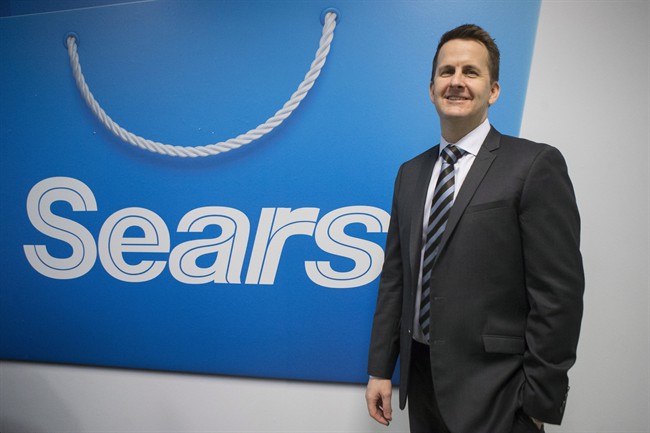TORONTO – Sears Canada isn’t interested in stocking high-priced runway styles and lavish decor because it’s not what middle-class shoppers want to buy, chief executive Douglas Campbell says.

While other stores such as Hudson’s Bay have added posh new brands in pursuit of well-heeled shoppers, Campbell said Canadians are smarter with their money and expectations that high-end retailers will find huge success here are misguided.
“That market is not as large as people think,” he said on Thursday following the company’s annual meeting.
“I don’t believe we’re going to inspire our core customer with a $150 butter dish in our home decor department.”
After touring Sears stores across the country Campbell said he reached a few conclusions about where Sears fits best, and he’ll put those insights into action while he attempts to turn the ship on its struggling sales figures.
He said the company has a clearly defined market appealing to middle-class families who are “pragmatic and generally frugal” with their shopping habits.
Whether those customers return to Sears department stores in droves remains to be seen.
Campbell spoke to a small group of investors at Sears Canada’s annual meeting, his first since taking the leadership role last fall. The event was hosted at the company’s headquarters in downtown Toronto, a few floors above the empty department store that Sears occupied several months ago.
- What is a halal mortgage? How interest-free home financing works in Canada
- Capital gains changes are ‘really fair,’ Freeland says, as doctors cry foul
- Budget 2024 failed to spark ‘political reboot’ for Liberals, polling suggests
- Starbucks looks likely to win U.S. Supreme Court case involving pro-union workers
Sears Canada is in the midst of a three-year turnaround plan that intensified when the company began a more aggressive reduction of staff aimed at lowering expenses.
Over the past year, Sears Canada has sold leases to some of its most prominent locations, many of which will reopen as upscale Nordstrom department stores within the next two years.
Luxury merchandise has become a bigger priority at other retailers too.
Hudson’s Bay is bringing Saks Fifth Avenue to Canada and expanding the labels it carries, while Holt Renfrew is opening more stores in the Toronto area.
However, outside the major cities, fashion priorities are different, and that’s something Campbell said he saw when he visited places like St. John’s, N.L., which is Sears Canada’s biggest store by sales volume.
“Our guy isn’t going to wear pink denim or green khakis,” he said. “Maybe if they get an edgy guy, he’ll wear navy blue.”
Just a year ago, Sears Canada was trying on a different look, one that strived to appeal to more trendy customers, under the leadership of then-CEO Calvin McDonald. When McDonald abruptly left the company last year, Sears Canada reverted to business approach that was more “inclusive” than “exclusive,” as Campbell calls it.
“(Our customers) may not be as fashion forward as we thought they were going to be,” he said.
“That’s a minor shift in terms of merchandise that we’re purchasing, not a major trajectory shift in how we’re driving the business.”
Sears Canada’s disappointing financial performance has been exacerbated by stiff competition across the retail sector.
During the annual meeting, Campbell outlined several ways he aims to boost flagging sales, which weakened 10 per cent in the most recent quarter.
Since January, the company has announced it will chop 2,200 employees from its payroll, on top of thousands more that it laid off last year. The retailer is trying to reduce costs and improve its overall business. Last year, the company made a similar round of cuts that has lowered its overall employee count to around 20,000 people.
Sears Canada also plans to invest $30 million over the next two or three years. The money will go towards a new inventory management system to replace infrastructure that has fallen behind many of its competitors.
The new technology will provide a clearer picture of what’s on shelves at each store, while the company also has other plans underway to enhance its website for a better online shopping experience.
“This is not rocket science, but it’s things we need to invest to make sure we have table stakes,” Campbell said.
“Investments in planning, allocation and infrastructure … is not something a company that’s going out of business does.”
While Campbell focuses on what’s inside his stores, other questions persist about whether Sears Canada will look for other ways to generate cash.
Last December, shareholders benefited from the sale of several leases when the company paid out a hefty dividend of $5 per share.
Nearly half a billion dollars of that went back to its largest shareholders, U.S. parent company Sears Holdings Corp. (Nasdaq:SHLD) and financier Edward Lampert, who together own 88.8 per cent of Sears Canada.
“We’re always open to opportunities to unlock real estate value when something presents itself that makes sense,” Campbell said after the annual meeting.
“There’s no asset sales that we’re actively engaged in now.”
— Follow @dj_friend on Twitter.

Comments